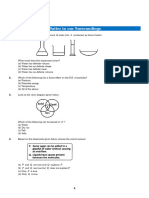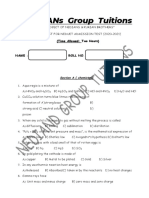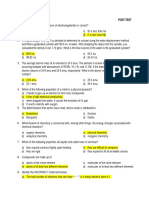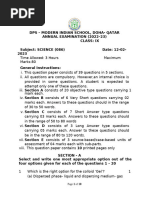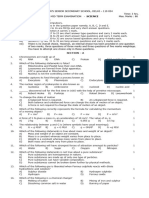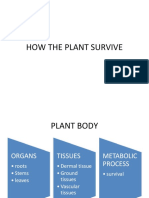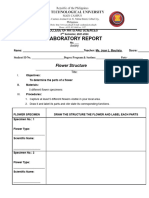Revision Test Sci 9 (23-24)
Revision Test Sci 9 (23-24)
Uploaded by
ridhipvt2009Copyright:
Available Formats
Revision Test Sci 9 (23-24)
Revision Test Sci 9 (23-24)
Uploaded by
ridhipvt2009Copyright
Available Formats
Share this document
Did you find this document useful?
Is this content inappropriate?
Copyright:
Available Formats
Revision Test Sci 9 (23-24)
Revision Test Sci 9 (23-24)
Uploaded by
ridhipvt2009Copyright:
Available Formats
DELHI INTERNATIONAL PUBLIC SCHOOL
REVISION TEST
SUBJECT: SCIENCE
CLASS: IX
Q1. MULTIPLE CHOICE QUESTIONS:
1. Evaporation of water increases with:
a) Decrease in surface area c) decrease in temperature
b) Increase in humidity d) increase in wind speed
2. Which of the following statements is not correct for gases?
a) gases have very low densities c) gases do not have fixed shape
b) gases have fixed volume d) gases flow easily
3. When we open a bottle of perfume , the fragrance spreads into air due to the
process of
a) effusion c) diffusion
b) osmosis d) plasmolysis
4. The conversion of a liquid into vapour phase below its boiling point is called
a) freezing c) sublimation
b) melting d) evaporation
5. Match the following:
COLUMN B
COLUMN A
Element Tyndall effect
Alloy Pure substances
Colloidal Homogeneous mixture
solution
metalloid Borderline character of metals and non-
metal
a) 1-a 2-b 3-c 4-d b) 1-b 2-c 3-d 4-a
c) 1-b 2-c 3-a 4-d d) 1-d 2-c 3-b 4-a
6. Which of the following is true about a compound?
a) it is a pure substance made up of only 1 type of atom.
b) it is a pure substance made up of molecules as their repeating unit.
c) It is impure substance having uniform composition
d) it is impure substance and show properties of metals
7. Which of the following is not a physical change?
a) melting of ice b) boiling of water
c) breaking of glass d) rusting of iron
8. Out of the following the example of suspension is:
a) vinegar b) salt solution
c) milk d) milk of magnesia
Passage based question:
Three states of matter are different from each other due to the difference in the
magnitude of the force of attraction between the constituent particles. In gases, inter
particle distances are the largest and inter particle force of attraction is the weakest.
Whereas in liquids, inter particle distances are somewhat shorter and inter particle
force of attraction is somewhat stronger. Therefore pressure is applied to convert a
gas into liquid. Pressure also affects the boiling point of a liquid. Boiling point
increases with increase in pressure and decreases with decrease in pressure. Boiling
point of pure liquid is fixed and it increases with the addition of impurities of other
substances. Extent of elevation in boiling point depends upon the nature and the
amount of substance added. Freezing point is lowered by the addition of impurities.
Boiling point is different from evaporation as it occurs at a particular temperature on
heating whereas evaporation occurs on its own at any temperature below its boiling
point.
9. If the B.P. after dissolution of common salt in water is found to be 102 degree
celsius at 1 atm then, the freezing point of that solution on cooling would be
a) 00 C b) +1.8 0 C
c) -1.80C d) may be more than or less than 0 0C
10. A substance is said to be a gas if
a) its BP is above the room temp.
b) the normal physical state of a substance is solid but due to absorption of heat it
gets converted to gaseous state.
c) it’s BP is below the room temp.
d) the normal physical state of a substance is liquid , but due to absorption of heat , it
gets converted into gaseous state
11. A vector quantity has
a) direction b)magnitude
c) both magnitude and direction d) none of these
12. Odometer of automobiles records
a) average speed b) instantaneous speed
c) distance travelled d) acceleration
13. The speedometer of a car measures
a) average speed b) acceleration
c) instantaneous speed c) none of these
14. If the distance time graph of a particle is parallel to the time axis , the velocity of
the particle is
a) unity b) zero
c) infinity d) none of these
15. Match the column:
COLUMN A COLUMN B
1. F=ma A Momentum
2. P=mv B Newton’s first law
3. If F=0 , C Newton’s second
v=constant law
a) 1-A 2-B 3-C
b) 1-B 2-C 3-A
c) 1-C 2-A 3-B
d) 1-B 2-A 3-C
16. An unbalanced force is necessary for an object to be
a) at rest b) in motion with a constant velocity
c) accelerated d) all of the preceding
17. Inertia
a) sets objects in motion
b) causes changes in motion
c) is the result of a net force
d) is directly proportional to the mass of an object
18. A passenger in a moving train tosses a coin which falls behind him .It means that
the motion of the train is
a) accelerated b) uniform
c) retarded d) along circular tracks
19. The rate of change of momentum wrt time is measured in
a) kg/m b) kg m
c) kgm/s2 d) kg m /s
20. A goal keeper in a game of football pulls his hands backwards after holding the
ball shot at the goal. This enables the goal keeper to
a) exert larger force on the ball
b) reduce the force exerted by the ball on hands
c) increase the rate of change of momentum
d) decrease the rate of change of momentum
21. The tissue present in the lining of kidney tubules and ducts of salivary
glands is
(a) squamous epithelium tissue
(b) glandular epithelium tissue
(c) cuboidal epithelium tissue
(d) columnar epithelium tissue
22. Sieve tubes and companion cells are present in
(a) xylem
(b) phloem
(c) cork
(d) cambium
23. A tissue whose cells are capable of dividing and re-dividing is called
(a) complex tissue
(b) connective tissue
(c) permanent tissue
(d) meristematic tissue
24.Dividing tissues present in plant called……………….
a) Parenchyma tissue
b) Meristematic tissue
c) Cell
d) None of them
25. …………………. Seen in some plants is located near the node
a) Apical meristem
b) Intercalary meristem
c) Parenchyma tissues
d) Roots
26.Sclerenchyma tissue are long, narrow and thickened due to……………
a) Stroma
b) Lignin
c) Thick walls
d) None of them
27. Animal cell lacking nuclei would also lack in
(a) Ribosome
(b) Lysosome
(c) Endoplasmic reticulum
(d) Chromosome
28. The phenomenon by which protoplast of a cell shrinks from the wall is
(a) Osmosis
(b) Plasmolysis
(c) Diffusion
(d) Glycolysis
29. The barrier between the protoplasm and the outer environment in an animal
cell is
(a) Cell wall
(b) Plasma membrane
(c) Nuclear membrane
(d) Cytoplasm
30. Ribosomes are the site of
(a) Photosynthesis
(b) Respiration
(c) Protein synthesis
(d) Absorption
You might also like
- Biology Notes IGCSE Cambridge 2014 PDFDocument376 pagesBiology Notes IGCSE Cambridge 2014 PDFSadia haque100% (4)
- Chem Xi Chap 2, Worksheet 3Document4 pagesChem Xi Chap 2, Worksheet 3nazish kiranNo ratings yet
- BLANKSDocument10 pagesBLANKSyeshathacker1682No ratings yet
- Matter in Our SorroundingDocument17 pagesMatter in Our SorroundingSaurabh KumarNo ratings yet
- Half Yearly Science Exam 9 24-25Document5 pagesHalf Yearly Science Exam 9 24-25Ramanjot KaurNo ratings yet
- GR9. NAFS ( (Physical Science) FORM 1Document16 pagesGR9. NAFS ( (Physical Science) FORM 1karim.mohammed.khalafNo ratings yet
- 7TH CPP 2Document8 pages7TH CPP 2shrikantdharne5No ratings yet
- 3RD Quarterly Assessment G8 Science Test PaperDocument2 pages3RD Quarterly Assessment G8 Science Test PaperAileen TorioNo ratings yet
- Science 24Document5 pagesScience 24aditiNo ratings yet
- mcqsDocument24 pagesmcqsnagarajusavithrammaNo ratings yet
- Apch01 pt02Document3 pagesApch01 pt02dheerajkumarsahNo ratings yet
- 2-Matter and Its Characteristics-1Document4 pages2-Matter and Its Characteristics-1ali133189No ratings yet
- MCQ & Fib-2023Document26 pagesMCQ & Fib-2023Vishal SNo ratings yet
- Science (4 Oct)Document5 pagesScience (4 Oct)heyitsrevaxoxoNo ratings yet
- 7TH CPP 3Document8 pages7TH CPP 3Snehal BiradarNo ratings yet
- Matter in Our Surroundings - MCQ Questions (Class-9)Document9 pagesMatter in Our Surroundings - MCQ Questions (Class-9)listenofficial16No ratings yet
- NEDIANs TEST.1Document16 pagesNEDIANs TEST.1Meer Umar0% (1)
- Properties of Matter and SoundDocument6 pagesProperties of Matter and SoundsaravanamoorthyNo ratings yet
- 11th Chemistry Mcqs by Youth AcademyDocument45 pages11th Chemistry Mcqs by Youth Academydemonslayer8029No ratings yet
- Class IX MID TERM EXAMINATION - 2022-23Document8 pagesClass IX MID TERM EXAMINATION - 2022-23Sujata DuttaNo ratings yet
- Chemistry Question BanakDocument14 pagesChemistry Question BanakBikash DasNo ratings yet
- Final Updated Model QuestionsDocument14 pagesFinal Updated Model Questionsbidush dahalNo ratings yet
- MCQ & Fib-2023Document26 pagesMCQ & Fib-2023RishiNo ratings yet
- science grade 9 (ch-1 matter around us)Document8 pagesscience grade 9 (ch-1 matter around us)shashuvathivbckNo ratings yet
- Science TestDocument6 pagesScience Testamit mongiaNo ratings yet
- Ix-Science-Set1-Sample-Hy 2024-25Document8 pagesIx-Science-Set1-Sample-Hy 2024-25cakeolovez89No ratings yet
- C1 - States of MatterDocument13 pagesC1 - States of MatterĐào ThảoNo ratings yet
- Class 9 sample science paperDocument4 pagesClass 9 sample science papermavititikshaNo ratings yet
- Sample Paper With Answers of PT 2 Exam - Science -Grade 9 -2024-25Document14 pagesSample Paper With Answers of PT 2 Exam - Science -Grade 9 -2024-25chadachanakarnNo ratings yet
- Science QP Mid Term Exam - 2023-24Document8 pagesScience QP Mid Term Exam - 2023-24hbcfhtymzpNo ratings yet
- Quiz1 - Fluidmechanics1 (DDA80066)Document7 pagesQuiz1 - Fluidmechanics1 (DDA80066)silent spritsNo ratings yet
- Set 1 - Multiple Choice Questions On Matter With AnswersDocument4 pagesSet 1 - Multiple Choice Questions On Matter With AnswersPriyanka GhugeNo ratings yet
- Mcqs Full Book (Chem)Document7 pagesMcqs Full Book (Chem)Shiraz MushtaqNo ratings yet
- Halfyearly Science IxDocument5 pagesHalfyearly Science Ixsivarajuyasi1234No ratings yet
- 9 TH Science SA-1Document4 pages9 TH Science SA-1sheetalbains106No ratings yet
- Mock - 1 - Final Day - EverythingDocument15 pagesMock - 1 - Final Day - Everythingaustinsojan2011No ratings yet
- CLASS IX (Matter in Our Surroundings) 01-06-2024 (BTC CBSE)Document4 pagesCLASS IX (Matter in Our Surroundings) 01-06-2024 (BTC CBSE)litsajosephNo ratings yet
- Chemistry Ix Holiday HomeworkDocument3 pagesChemistry Ix Holiday HomeworkDebjani BasuNo ratings yet
- Bridge Course Practice Test 15 Enova EducationDocument10 pagesBridge Course Practice Test 15 Enova Educationrhancy77No ratings yet
- 406 (1)Document4 pages406 (1)sukanyatomar61No ratings yet
- ChemistryDocument9 pagesChemistryghulaan11No ratings yet
- GK. Mock Test.Document11 pagesGK. Mock Test.AmanNo ratings yet
- Session 1 Post-TestDocument4 pagesSession 1 Post-TestHelen BillonesNo ratings yet
- MS-CH-1-SCANNER-TERM-1-CHEM-IX-Document19 pagesMS-CH-1-SCANNER-TERM-1-CHEM-IX-sujatamohapatra12No ratings yet
- 9 Science Term 1Document12 pages9 Science Term 1vegasharry3No ratings yet
- 11th Physics Mcqs - Punjab BoardDocument84 pages11th Physics Mcqs - Punjab BoarddeathbymothballsNo ratings yet
- R - Ch 11 ALL ReviewsDocument9 pagesR - Ch 11 ALL Reviewsfathimalanabza842No ratings yet
- NTSE Practice Paper - 10 Scholastic Aptitude Test (Science)Document4 pagesNTSE Practice Paper - 10 Scholastic Aptitude Test (Science)pagalNo ratings yet
- Class 9th Half YearlyDocument5 pagesClass 9th Half Yearlyshrikrishan1199No ratings yet
- 2019 Dec. CH352-CDocument6 pages2019 Dec. CH352-Cnaagin12300No ratings yet
- Namma Kalvi 11th Chemistry Revision Test Question Papers EM 221210Document10 pagesNamma Kalvi 11th Chemistry Revision Test Question Papers EM 221210forever gamersNo ratings yet
- Matter in Our Surroundings ClassDocument16 pagesMatter in Our Surroundings Classanuragmittal616No ratings yet
- Answer The Following Questions: A) 1.2x10 Pa B) 2.4x10 Pa C) 3.0x10 Pa D) 4.1x10 PaDocument3 pagesAnswer The Following Questions: A) 1.2x10 Pa B) 2.4x10 Pa C) 3.0x10 Pa D) 4.1x10 PaAhmad100% (1)
- ExtraDocument10 pagesExtraafrozasheuly86No ratings yet
- Science MTDocument4 pagesScience MTUtkarsh ChoudharyNo ratings yet
- Physical ScienceDocument189 pagesPhysical ScienceBapa LoloNo ratings yet
- 9th-Science-Prelim 2-QP-24-08-2024Document5 pages9th-Science-Prelim 2-QP-24-08-2024francejaks29No ratings yet
- IOE SET 6 Questions 2023Document8 pagesIOE SET 6 Questions 2023Abhishek8101No ratings yet
- Chem 101 Ex1 Review QuestionsDocument35 pagesChem 101 Ex1 Review QuestionsJohn Lloyd PaduaNo ratings yet
- Ch-10, Ch-1 MCQDocument2 pagesCh-10, Ch-1 MCQanis.zamanNo ratings yet
- X-MATHEMATICS MCQDocument11 pagesX-MATHEMATICS MCQridhipvt2009No ratings yet
- Unseen Passage-2 (Grade-9)Document3 pagesUnseen Passage-2 (Grade-9)ridhipvt2009No ratings yet
- X-Maths MCQ KEYDocument8 pagesX-Maths MCQ KEYridhipvt2009No ratings yet
- Maths Worksheet Term - 1 (23-24)Document4 pagesMaths Worksheet Term - 1 (23-24)ridhipvt2009No ratings yet
- PremiumPaidStatement 2023-2024 (1)Document1 pagePremiumPaidStatement 2023-2024 (1)ridhipvt2009No ratings yet
- Metal and Non MetalsDocument7 pagesMetal and Non Metalsridhipvt2009No ratings yet
- SCIENCE Sample Paper-1 (With Answer)Document14 pagesSCIENCE Sample Paper-1 (With Answer)ridhipvt2009No ratings yet
- Unit 3 Body Systems Study Guide 2018Document6 pagesUnit 3 Body Systems Study Guide 2018sukhmitjheetaNo ratings yet
- Biology BookDocument51 pagesBiology BookRam NepaliNo ratings yet
- Hsslive Class XI Deleted Topics by Scert 2022Document15 pagesHsslive Class XI Deleted Topics by Scert 2022UnniNo ratings yet
- Cbse Class IX Science Sample Paper - 5 Time: 3 Hrs Total Marks: 80Document18 pagesCbse Class IX Science Sample Paper - 5 Time: 3 Hrs Total Marks: 80Vedang GuptaNo ratings yet
- Important Kerala HerbsDocument408 pagesImportant Kerala HerbsMethavi100% (1)
- Life and Its Remarkable BeginingsDocument24 pagesLife and Its Remarkable Beginingsdreample1003No ratings yet
- Cell Wall: by Fajrie AchlanaDocument35 pagesCell Wall: by Fajrie Achlanafajrieachlana100% (1)
- 9th Science Practical E.MDocument17 pages9th Science Practical E.Mamuthasenthan47100% (1)
- Avalon Effect Ritz 2012Document83 pagesAvalon Effect Ritz 2012jon_ritzNo ratings yet
- MSC Botany Paper-VIII Unit-2Document17 pagesMSC Botany Paper-VIII Unit-2SR GLOBAL TECHNOLOGY Sr GHATALANo ratings yet
- Botany and Zoology (Grade 12-Biology Reviewer)Document12 pagesBotany and Zoology (Grade 12-Biology Reviewer)Patricia GarciaNo ratings yet
- 5090 w16 QP 12 PDFDocument24 pages5090 w16 QP 12 PDFStop spamming on weverseNo ratings yet
- Epiglu - Instructions For UseDocument2 pagesEpiglu - Instructions For Usezeinabhabeeb100% (1)
- Microbiology Pointers To ReviewDocument12 pagesMicrobiology Pointers To ReviewEdna ChanNo ratings yet
- How The Plant SurviveDocument16 pagesHow The Plant SurvivedhonaNo ratings yet
- Cell & Tissue StructureDocument19 pagesCell & Tissue StructureBrintha Kani KumarNo ratings yet
- Levels of Organization Power Point and ActivityDocument8 pagesLevels of Organization Power Point and ActivityJudy RianoNo ratings yet
- Biology Capsule PDFDocument15 pagesBiology Capsule PDFShubhneetNo ratings yet
- Chapter 5 TissuesDocument25 pagesChapter 5 TissuesPrinces Eunice DenostaNo ratings yet
- Biology Form 1 NotesDocument90 pagesBiology Form 1 NotesMARENDE CYBER100% (1)
- The Animal Kingdom: Animals Cleary DominateDocument10 pagesThe Animal Kingdom: Animals Cleary DominateJacquiline SantiagoNo ratings yet
- Plant Defences GCSEDocument2 pagesPlant Defences GCSENoor Ulain NabeelaNo ratings yet
- Lab Growing Meat Production From Stem CellDocument7 pagesLab Growing Meat Production From Stem CellNguyễn AnhNo ratings yet
- Anatomy & Physiology: The Unity of Form and Function (Loq Quality) 9th Edition Kenneth Saladin 2024 Scribd DownloadDocument49 pagesAnatomy & Physiology: The Unity of Form and Function (Loq Quality) 9th Edition Kenneth Saladin 2024 Scribd Downloaddwantoninawe100% (1)
- Flower Structure Lab Activity - BotanyDocument14 pagesFlower Structure Lab Activity - BotanyAirene avilesNo ratings yet
- Plant AnatomyDocument22 pagesPlant AnatomyYogesh Bagad100% (2)
- Master File - ChronicDocument671 pagesMaster File - ChronicsubhojitnayekNo ratings yet
- New Era Public School Mayapuri New Delhi: MADE BY - Jaasmine Kaur Ix - C Roll No. - 31Document13 pagesNew Era Public School Mayapuri New Delhi: MADE BY - Jaasmine Kaur Ix - C Roll No. - 31Jasmine KaurNo ratings yet
- Histo 2Document11 pagesHisto 2pratiwi kusumaNo ratings yet















